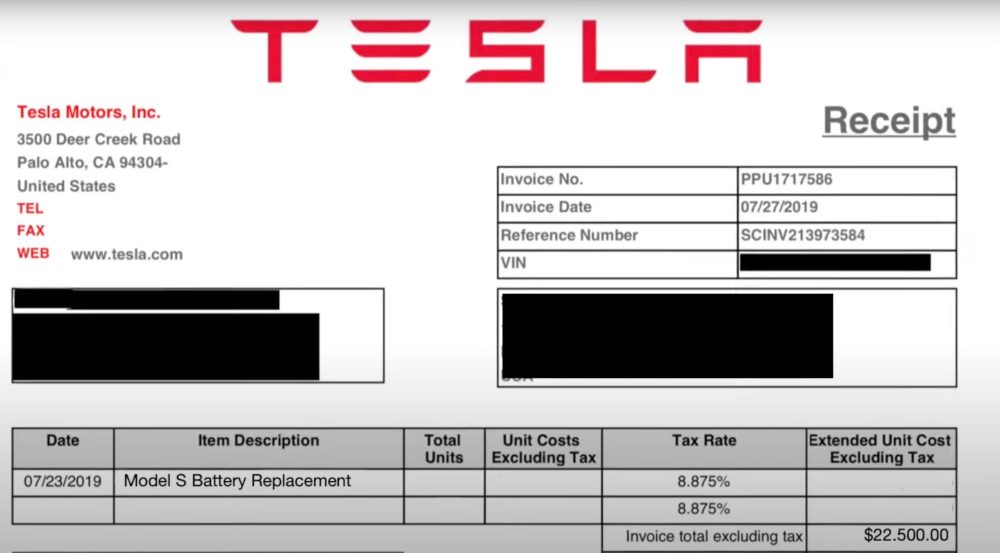Tesla has tried to charge a Model S owner $22,500 for a battery pack replacement out of warranty, but a third-party shop was able to fix the issue for a fraction of that cost.
As a Tesla owner, one of the most common questions I get asked is, “How much does it cost if you need to replace the battery pack?”
It’s a hard question to answer since the vast majority of Tesla battery replacements have been done under warranty. Early on, Tesla offered eight-year unlimited mileage powertrain warranties for Model S and Model X.
With Model S production starting in 2012 and higher volumes not coming until 2014, only recently have those vehicles started to come off their powertrain warranty. We have seen quotes from Tesla for battery pack replacements between $20,000 and $30,000. That’s a lot of money, but the good news is that Tesla’s battery packs have been known to last a long time.
I have a Tesla Model X that had a battery pack last for more than 300,000 miles.
However, when the problem is not necessarily battery degradation and the battery pack simply fails, Tesla has been known to be quick to suggest a replacement rather than try to fix the battery pack.
That was the case of Tyler Hoover of Hoovie’s Garage after he bought a 2013 Model S P85. The electric vehicle, which was four months out of battery warranty, started to display a “maximum battery charge level reduced” error message and couldn’t be charged above 50 miles.

He brought the vehicle to his local Tesla’s service center, which offered him a battery pack replacement for $22,500:

After learning that Youtuber Rich Rebuilds’
Electrified Garage has had some experience with those kinds of repairs,
Hoover sent his Model S to their Florida location.
While Tesla recently started opening up some of its diagnostic tools to third parties, the automaker still has a lot of limitations when it comes to powertrain diagnostics.
Electrified Garage uses some hacks to get past that and figure out what is wrong with the pack. In this case, they detected some voltage imbalances in 2 of the 16 battery modules:

They simply replaced those modules instead of the whole battery pack:
“We were able to drop the battery and replace modules in the pack to fix the issue for about 75% off the quoted Tesla Service Center price. This is the importance of both Right to Repair, and having skilled technicians available at service centers to properly diagnose issues with solutions that are not wasteful, or overly extreme in cost. The sustainability aspect is most alarming, as we are coming up to most older Model S and X vehicles being out of warranty. “
The entire process, which is not exactly simple, to be fair, was documented in Rich’s latest video:
So how much did it cost? The modules were $1,500 each, for a total of $3,000. Another $750 in parts for contractors and fuses, with the main one being upgraded to the ones introduced in the Model S Ludicrous.
With diagnostic and labor, it came up to about $5,000, or about 75% less than Tesla was quoting for a full battery pack replacement.
Electrek‘s take
I know a new battery pack is not the same as just two replacement modules, but you need to have the option.
A $22,500 repair is not financially viable on a vehicle currently quoted at about $25,000-$30,000.
I understand if Tesla doesn’t want to get involved in that kind of service repair. They want to replace the battery pack, send the old pack to its pack remanufacturing team, and refurbish it where it has the expertise to do so.
That’s fair. But if you don’t want to do it, you have to let third-party shops be able to offer alternatives and they need diagnostic tools to do that. Otherwise, they have to rely on some hacks, which is not ideal.
I hope Tesla gets onboard with ‘right to repair’ and starts to empower more third-party repair shops as more of its early vehicles are now getting off of warranty.
Because, if they don’t, its seemingly noble push to offer service through company-owned shops is going to start to look less noble.
FTC: We use income earning auto affiliate links. More.
Subscribe to Electrek on YouTube for exclusive videos and subscribe to the podcast.